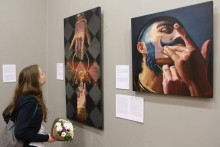The exhibition of Ruta and Inokentii Korshunov is hosted by the Zelena Kanapa Gallery. The display involves about two dozen works created by the artists over the past year. The painters stress that it is a non-profit project, a case of art for the sake of art.
The Korshunov couple lived until recently in Irpin near Kyiv before moving to live and work in Slovenia. Ruta paints in a realistic manner, mostly with oil paints and with an emphasis on still lifes and household items. Inokentii seeks and finds self-realization in many forms of art. He says that his forays into sculpture, painting, graphics, book illustration, and even digital art have been greatly affected by his passion for the age of Renaissance. The artist says he mostly works in a realistic manner, using it to study various environments. The Korshunovs also cooperate as illustrators with publishers A-BA-BA-HA-LA-MA-HA and Zelenyi Pes.
Meanwhile, “The Diatonic Garden” project is an attempt to speak about the past in a somewhat different way. The works included in it intertwine modernity and mythology of ancient peoples. The artists designed and implemented this project together.
“The world around us is far greater than hopelessly gray routine and dazzling white fictions, and of course, it is not limited to the spectral colors, which are so few,” the artists told us about the project’s meanings. “We are surrounded by semitones. That is why the fates of even those characters that are well-known to us since childhood are shrouded in mystery, as clarity and definitive answers are just not there. Despite sentences passed by time and circumstances which no one will ever know for sure, most historical and mythical figures are always very controversial. Neither bloodthirsty Elizabeth Bathory nor sly kitsune fox shape-shifter ever stood next to a modern human. Why not to give free rein to one’s imagination then, and to assume that a totally different order of things exists?”
The Korshunovs’ paintings include Golem. Waiting; Golem. The Tree of Destiny; Bluebeard. The Keys; Bluebeard. Shaving; The Labyrinth and the Minotaur; Ariadne’s Thread; Medusa, etc. The infinite series of images making up “The Diatonic Garden” generates more and more questions...
“I was not familiar with the work of these artists until recently. The Korshunovs themselves offered me to hold a display of “The Diatonic Garden” by sending photos of the paintings over the Internet,” said art critic Olesia Domaradzka. ‘The works got me interested, firstly, because of surprisingly masterful execution. The styling is also interesting. The stories behind the paintings are out of the ordinary as well. This theme, I mean retelling certain myths and legends, is actually quite difficult to illustrate because it is easy to sink to kitsch or, say, excessive illustrativeness and narrativeness... And when artists still set out to work on this subject, they rarely succeed. Meanwhile, when we turn to the Korshunov couple’s work, it is successful in every regard, I believe. I even think that this is hardly an illustrative project, as it is rather a series of allusions to characters or myths.”
Domaradzka added that the creative work of the present guests of the Zelena Kanapa was unlike that of Lviv artists who rarely paint in such a naturalistic manner and rarely turn to globally important stories, such as Jewish legends. “Our school is, after all, dominated by aestheticism, when the story is given less weight than the emotion,” noted the art critic.
By the way, most of the works presented as part of “The Diatonic Garden” project were painted by the Korshunovs together, using two brushes. “It happens sometimes in art that two people meet up and inspire each other,” Domaradzka explained it. “When the artists in question are of the same sex, like Paul Gauguin and Vincent Van Gogh, it always causes some conflicts triggered by competition, rivalry. If they are a couple, meanwhile, which is probably dominated by love and understanding and is aware that they give each other inspiration and creative impulses, they agree to make their creative work a shared effort.” Domaradzka added that “such complementarity is a rarity in art, but it is always very interesting.”
Visitors are welcome to enter “The Diatonic Garden” and evaluate the Korshunovs’ attempt to speak about the past in a somewhat different way till April 2.







